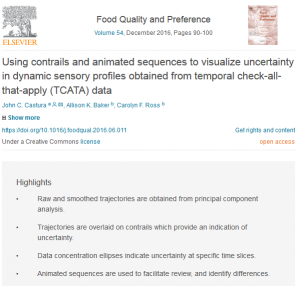Using contrails and animated sequences to visualize uncertainty in dynamic sensory profiles obtained from temporal check-all-that-apply (TCATA) data
 Approaches for analyzing temporal check-all-that-apply (TCATA) data are further developed and illustrated using data arising from a Syrah wine finish evaluation. Raw and smoothed trajectories are obtained using principal component analysis. Virtual panels are obtained from a partial bootstrap, and the attribute citation proportions are then projected into the solution space to form contrails. Trajectories are overlaid on the contrails, allowing smoothing to be evaluated. Separation between two contrails provides evidence that the trajectories differ. At individual time slices, data concentration ellipses are overlaid on bootstrap scores. Separation of ellipses provides evidence of differences among treatments. Difference trajectories and difference ellipses can also be plotted; if the difference ellipse excludes the origin it indicates a difference between the treatments. Animated sequences summarize changes in product characterization over time in a manner that facilitates review. A glossary of terms introduced in the paper is provided in an appendix.
Approaches for analyzing temporal check-all-that-apply (TCATA) data are further developed and illustrated using data arising from a Syrah wine finish evaluation. Raw and smoothed trajectories are obtained using principal component analysis. Virtual panels are obtained from a partial bootstrap, and the attribute citation proportions are then projected into the solution space to form contrails. Trajectories are overlaid on the contrails, allowing smoothing to be evaluated. Separation between two contrails provides evidence that the trajectories differ. At individual time slices, data concentration ellipses are overlaid on bootstrap scores. Separation of ellipses provides evidence of differences among treatments. Difference trajectories and difference ellipses can also be plotted; if the difference ellipse excludes the origin it indicates a difference between the treatments. Animated sequences summarize changes in product characterization over time in a manner that facilitates review. A glossary of terms introduced in the paper is provided in an appendix.
![]()
Castura, J. C., Baker, A. K., & Ross, C. F. (2016). Using contrails and animated sequences to visualize uncertainty in dynamic sensory profiles obtained from temporal check-all-that-apply (TCATA) data. Food Quality and Preference, 54, 90-100. https://doi.org/10.1016/j.foodqual.2016.06.011